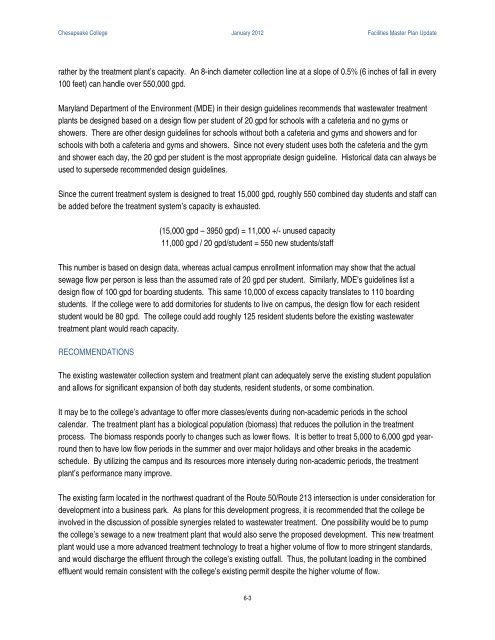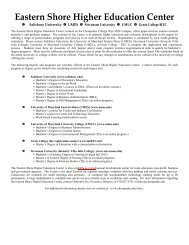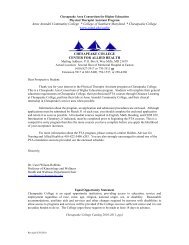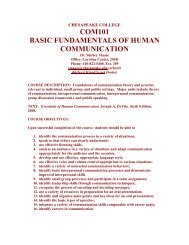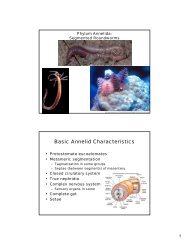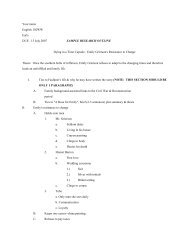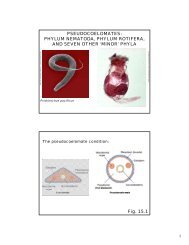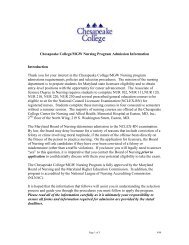Facilities Master Plan - 2012 - Chesapeake College
Facilities Master Plan - 2012 - Chesapeake College
Facilities Master Plan - 2012 - Chesapeake College
You also want an ePaper? Increase the reach of your titles
YUMPU automatically turns print PDFs into web optimized ePapers that Google loves.
<strong>Chesapeake</strong> <strong>College</strong> January <strong>2012</strong> <strong>Facilities</strong> <strong>Master</strong> <strong>Plan</strong> Updaterather by the treatment plant’s capacity. An 8-inch diameter collection line at a slope of 0.5% (6 inches of fall in every100 feet) can handle over 550,000 gpd.Maryland Department of the Environment (MDE) in their design guidelines recommends that wastewater treatmentplants be designed based on a design flow per student of 20 gpd for schools with a cafeteria and no gyms orshowers. There are other design guidelines for schools without both a cafeteria and gyms and showers and forschools with both a cafeteria and gyms and showers. Since not every student uses both the cafeteria and the gymand shower each day, the 20 gpd per student is the most appropriate design guideline. Historical data can always beused to supersede recommended design guidelines.Since the current treatment system is designed to treat 15,000 gpd, roughly 550 combined day students and staff canbe added before the treatment system’s capacity is exhausted.(15,000 gpd – 3950 gpd) = 11,000 +/- unused capacity11,000 gpd / 20 gpd/student = 550 new students/staffThis number is based on design data, whereas actual campus enrollment information may show that the actualsewage flow per person is less than the assumed rate of 20 gpd per student. Similarly, MDE’s guidelines list adesign flow of 100 gpd for boarding students. This same 10,000 of excess capacity translates to 110 boardingstudents. If the college were to add dormitories for students to live on campus, the design flow for each residentstudent would be 80 gpd. The college could add roughly 125 resident students before the existing wastewatertreatment plant would reach capacity.RECOMMENDATIONSThe existing wastewater collection system and treatment plant can adequately serve the existing student populationand allows for significant expansion of both day students, resident students, or some combination.It may be to the college’s advantage to offer more classes/events during non-academic periods in the schoolcalendar. The treatment plant has a biological population (biomass) that reduces the pollution in the treatmentprocess. The biomass responds poorly to changes such as lower flows. It is better to treat 5,000 to 6,000 gpd yearroundthen to have low flow periods in the summer and over major holidays and other breaks in the academicschedule. By utilizing the campus and its resources more intensely during non-academic periods, the treatmentplant’s performance many improve.The existing farm located in the northwest quadrant of the Route 50/Route 213 intersection is under consideration fordevelopment into a business park. As plans for this development progress, it is recommended that the college beinvolved in the discussion of possible synergies related to wastewater treatment. One possibility would be to pumpthe college’s sewage to a new treatment plant that would also serve the proposed development. This new treatmentplant would use a more advanced treatment technology to treat a higher volume of flow to more stringent standards,and would discharge the effluent through the college’s existing outfall. Thus, the pollutant loading in the combinedeffluent would remain consistent with the college’s existing permit despite the higher volume of flow.6-3


